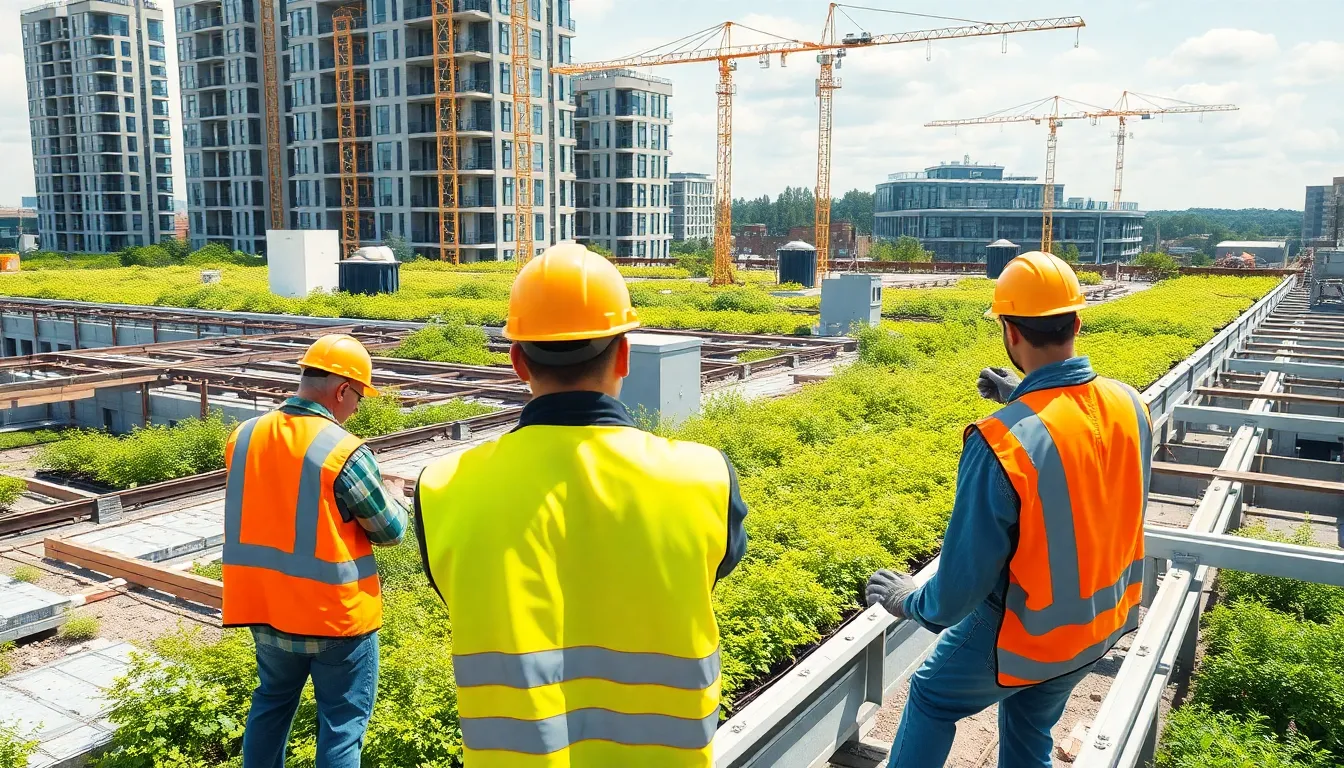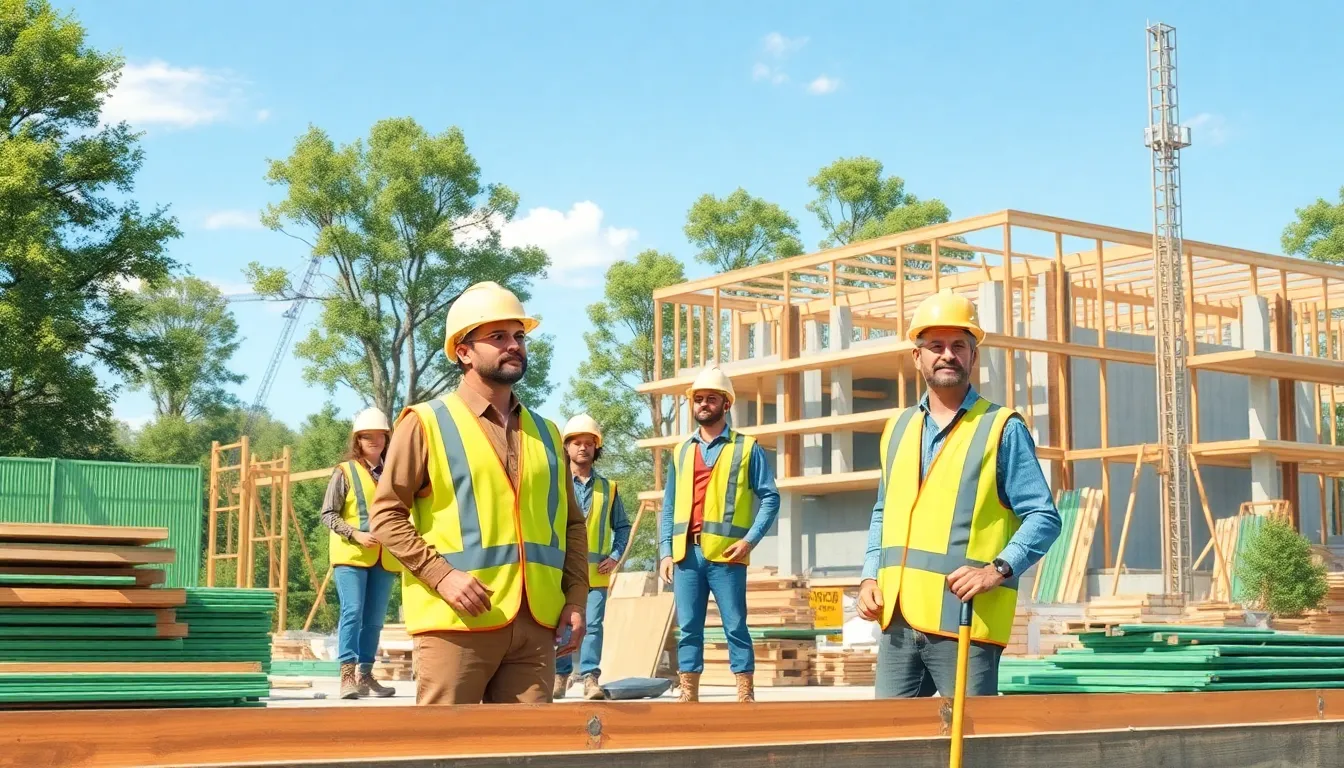Table of Contents
ToggleIn a world where building a house often feels like a game of Jenga, sustainable construction technology is the superhero we didn’t know we needed. Imagine a construction site where eco-friendly materials meet cutting-edge innovation, all while saving the planet one brick at a time. It’s not just about making things look pretty; it’s about creating structures that stand the test of time—without leaving a carbon footprint the size of Bigfoot.
As the construction industry grapples with its environmental impact, sustainable technology emerges as the game-changer. From energy-efficient designs to waste-reducing methods, these advancements are paving the way for a greener future. So, whether you’re a builder, a homeowner, or just a curious bystander, buckle up for a journey into the world of sustainable construction that’s both enlightening and entertaining. Who knew saving the planet could be this much fun?
Overview of Sustainable Construction Technology
Sustainable construction technology focuses on minimizing environmental impacts while enhancing building efficiency. Various stakeholders, including builders, architects, and homeowners, prioritize eco-friendly practices. Innovations in materials, such as recycled steel and bamboo, enable stronger, more sustainable structures.
Energy-efficient systems, like solar panels and geothermal heating, contribute to reduced energy consumption. Advanced building techniques, including modular construction and 3D printing, streamline processes and decrease waste. Green roofs and living walls provide insulation, improve air quality, and promote biodiversity.
Lifecycle assessments play a crucial role in evaluating the environmental impact of construction projects. These assessments quantify emissions and resource usage throughout a building’s life, encouraging responsible decision-making. Certification programs, such as LEED and BREEAM, support the adoption of sustainable practices by recognizing environmentally responsible projects.
Regenerative design emerges as a forward-thinking approach, focusing on creating buildings that restore natural habitats and ecosystems. Designers incorporate passive solar design principles to maximize natural light and minimize energy use. Water-saving fixtures and rainwater harvesting systems reduce overall water consumption.
Emerging technologies, like smart building systems, allow for real-time energy monitoring and management. These systems optimize resource use, further lowering carbon emissions. Integration of sustainability into building codes and regulations promotes industry-wide adherence to eco-friendly practices.
Advancements in sustainable construction technology pave the way for a greener future in the building industry. With ongoing innovation, construction professionals continue to explore new methods that enhance sustainability and efficiency.
Benefits of Sustainable Construction Technology


Sustainable construction technology offers numerous benefits that enhance environmental quality and economic viability. Its focus on eco-friendly practices significantly affects multiple aspects of the construction industry.
Environmental Impact
Sustainable construction methods reduce waste and lower carbon emissions, promoting a healthier environment. Utilizing recycled materials, like steel, significantly decreases the need for raw resource extraction. Smart building systems optimize energy consumption, making structures more efficient. Green roofs and living walls not only provide insulation but also improve urban air quality. Lifecycle assessments evaluate projects’ environmental impacts, guiding stakeholders toward better decisions. Practicing regenerative design restores natural habitats, fostering biodiversity. Overall, these approaches contribute to a sustainable future by minimizing ecological footprints and enhancing resource efficiency.
Economic Advantages
Cost savings emerge as a key benefit of sustainable construction technology. Energy-efficient systems lead to lower utility bills, making long-term operation more economical. Investing in sustainable materials often results in reduced maintenance costs due to their durability. Certification programs, such as LEED, increase property values by attracting environmentally conscious buyers. Innovations like modular construction reduce project time and labor costs, streamlining the building process. Even tax incentives for green building practices enhance financial viability for developers. These economic advantages demonstrate that sustainable construction not only benefits the planet but also presents a practical investment opportunity.
Key Technologies in Sustainable Construction
Innovative technologies drive the future of sustainable construction, focusing on efficiency and environmental stewardship. Several key advancements enhance the industry’s approach to eco-friendly building practices.
Renewable Energy Sources
Solar energy captures sunlight to produce electricity and heating for buildings. Wind energy harnesses wind power, providing clean, renewable electricity. Geothermal systems utilize the earth’s heat for climate control and hot water. Utilizing these sources significantly minimizes reliance on fossil fuels, cutting greenhouse gas emissions. Energy storage solutions, such as batteries, complement these systems, ensuring energy availability during peak usage times and enhancing grid stability.
Smart Materials
Smart materials adapt to environmental changes and improve building efficiency. Phase change materials store and release thermal energy, ensuring consistent indoor temperatures. Self-healing concrete contains agents that repair cracks, extending building lifespans and reducing maintenance costs. Additionally, photochromic and thermochromic materials enhance energy efficiency by adjusting light and heat absorption. These smart materials contribute significantly to energy savings and sustainability, showcasing how technology can revolutionize construction practices.
Challenges in Implementing Sustainable Construction Technology
Sustainable construction technology faces several challenges that can hinder its effective adoption and implementation.
Cost Considerations
High initial investment often deters stakeholders from opting for sustainable materials and technologies. For example, renewable energy systems like solar panels may require significant upfront costs despite long-term savings. Budget constraints limit the ability of builders to prioritize eco-friendly solutions. Cost-benefit analyses reveal that benefits accrue over time, yet many projects overlook this aspect. Project financing options that offer lower interest rates for green projects remain underutilized. Financial incentives from local governments can alleviate costs but aren’t widely communicated or accessed.
Regulatory Barriers
Complex regulations surrounding sustainable building practices hamper progress in this sector. Building codes may not accommodate innovative sustainable technologies, leading to compliance challenges. Variability in policies across regions creates confusion and inconsistency in implementation. Additionally, certification programs like LEED and BREEAM may involve lengthy and complicated processes that discourage participation. Many municipalities lack clear guidelines on the integration of sustainable practices, creating obstacles for builders. Existing regulations often prioritize traditional construction methods over sustainable innovations, further stalling advancement in the sector.
Future Trends in Sustainable Construction Technology
Emerging technologies play a crucial role in shaping the future of sustainable construction. Enhanced energy efficiency systems integrate renewable energy sources like solar, wind, and geothermal, reducing reliance on fossil fuels. Smart building systems utilize advanced sensors and automation to optimize energy use while ensuring occupant comfort.
Innovative materials continue to transform construction practices. Self-healing concrete prevents structural degradation over time, extending the lifespan of buildings. Phase change materials effectively regulate indoor temperatures, contributing to energy savings by minimizing heating and cooling demands.
Modular construction methods gain traction as they enable offsite fabrication, reducing waste and construction time. Prefabrication techniques allow for precise material use and streamline the assembly process, making projects more efficient.
In addition to technological advancements, the focus on biomimicry fosters sustainable design principles. Architects draw inspiration from nature, resulting in energy-efficient structures that harmonize with their environments. Green infrastructure, such as urban forests and water-sensitive designs, also enhances urban resilience against climate change.
Sustainability certifications continue to influence building practices. Programs like LEED and BREEAM encourage adherence to eco-friendly standards, promoting market demand for green buildings. Owners of certified structures often enjoy increased property values and long-term cost savings from energy-efficient systems.
Collaboration among industry stakeholders remains essential for widespread adoption of sustainable practices. Builders, architects, and policymakers must work together to address regulatory challenges and create supportive frameworks for innovation. Emerging financing options facilitate investment in sustainable technologies, making them more accessible to a broader audience.
Investments in research and development drive further advancements. Continuous exploration of new materials and construction techniques paves the way for a greener, more sustainable construction industry.







